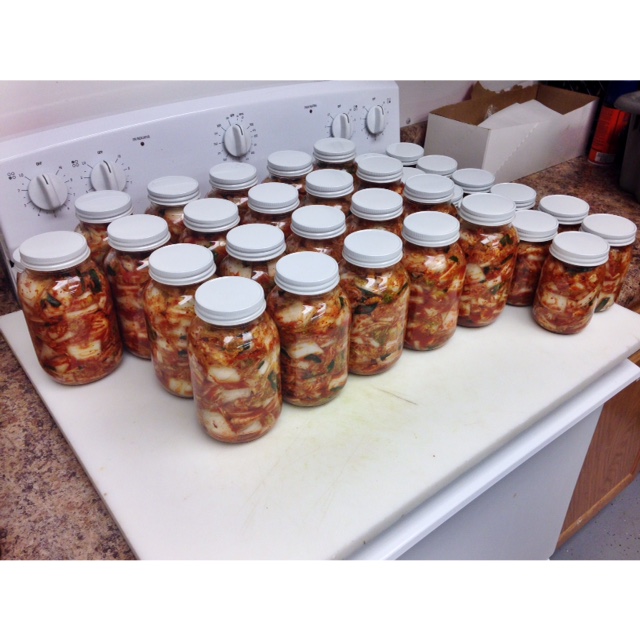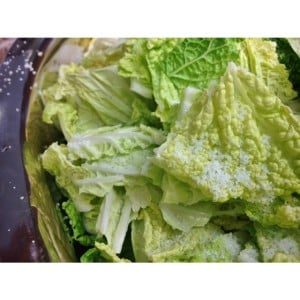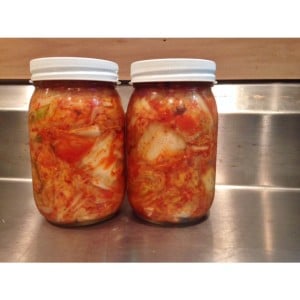–Marlyn McClendon, High Rocks, Hillsboro, WV
Hello Grow Appalachia Community,
My name is Marlyn and I am a Grow Appalachia participant here at High Rocks Educational Corporation. Recently I began my own business, Appalasian Kitchen. I will be selling a value-added product that is a family tradition, kimchi. I was raised in West Virginia, so the word Appalasian comes from how I culturally identify, my father is from West Virginia and my mother from South Korea. Some of my first memories as a child are eating kimchi with rice, rolled up in lightly salted seaweed. Delicious.
So what is kimchi? Kimchi is a fermented vegetable and loosely translates to “Salted Vegetable”, there are over a 100 different kinds. Kimchi is a staple for every Korean meal. The one that is most iconic to Korean cuisine and culture is the Napa cabbage variety, bright red in color, due to the Korean crushed red pepper and mixed with green onions, garlic, ginger, and carrots. However, kimchi can be made with a variety of different vegetables, radishes, scallions, cucumbers and more. There are also several varieties of kimchi that are not spicy.
In a short summary, kimchi begins with the Napa cabbage; it is cut and brined with salt, rinsed, then mixed with a variety of vegetables and spices. Usually, once you pack everything into a jar, the kimchi is left to set at room temperature for about a day, which jumpstarts the fermentation process. Then you place kimchi in the refrigerator to slow down the fermentation. Kimchi is a live product, so it continues to ferment and ripen over time. As it ferments, it will release CO2, so it’s natural for the kimchi to release some bubbles when you open it. It will change in texture and flavor as it ages. However, it doesn’t go bad necessarily. Koreans just use kimchi differently as it ages, using it in stew, sautéed, or stir-frys. Personally, I put my kimchi in everything, I mean absolutely everything. Nutritionally, kimchi is great for a variety of reasons; it is rich in probiotics, like yogurt. The lacto bacillus that is in the kimchi helps aid the microorganisms in your intestinal tract and helps your digestive system stay healthy. Kimchi is also loaded with vitamins and minerals.
When I started this business there were several things that motivated me. First, I wanted to start my own business because I think entrepreneurialism is one way that my state, West Virginia, can make a more sustainable future for itself. Second, I wanted it to be agricultural based, over the years I have become more aware of what I eat and where my food comes from. I believe in foods that are not sprayed with pesticides, grown in season and locally, made with love, and available to the public. What is that quote I’ve heard before, “Pay your farmer now, so you don’t have to pay the doctor later” or something like that? I think that is true. Lastly, I believe in supporting an agricultural economy for West Virginia and my local community. I am working with local farmers to grow my Napa cabbage and other ingredients, so that my kimchi can be West Virginian grown.
So, how far have I gotten in the process to market? Well, I’ve been making kimchi forever, but I refined the recipe, and had friends, family and community taste it. Yay, they love it and I love it too. So, recipe check! Next, I have got 300 jars and lids, waiting for my product and I have all the kitchen supplies necessary for making my kimchi. Check! I have registered my business with the state and paid the fees. Check! I have found organic Napa cabbage with a company from Virginia. I had to do this because you can’t buy organic Napa anywhere close to Pocahontas County, so just in case I don’t have local cabbage at the time, I will have an organic source and can continue making my product. Check! Lastly, I have a friend who is working on my logo for the label, which is an important part in getting my kimchi branded and approved for market. Check! Locally sourced garlic, salt, and scallions, check! Locally sourced Napa being grown, check!
Currently, the biggest hurdle is FDA certifying the kitchen here at High Rocks so that I can process my kimchi and sell it to retailers and farmer’s markets. This is no small feat. There are a lot of detailed steps, paperwork, and coordinating with different organizations to begin to complete an application. It is tedious and somewhat overwhelming, but I really believe in my kimchi and know that people love it. So, I keep on trucking! Thanks for reading about my kimchi and if you ever want to contact me about it or have advice, email me at marlyn@highrocks.org.






Best of luck! Sounds wonderful!